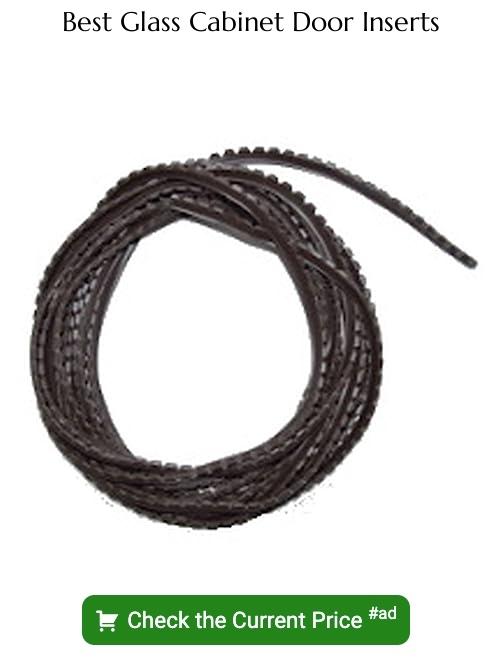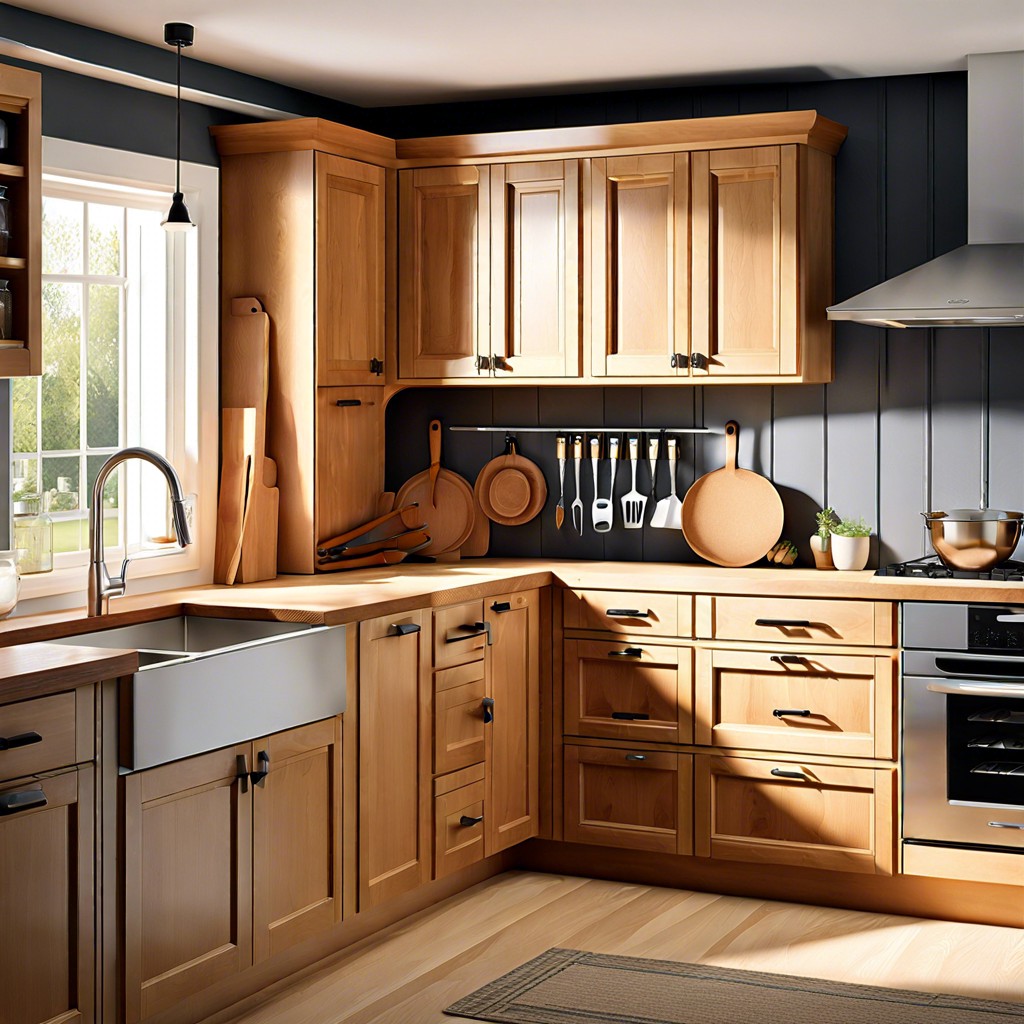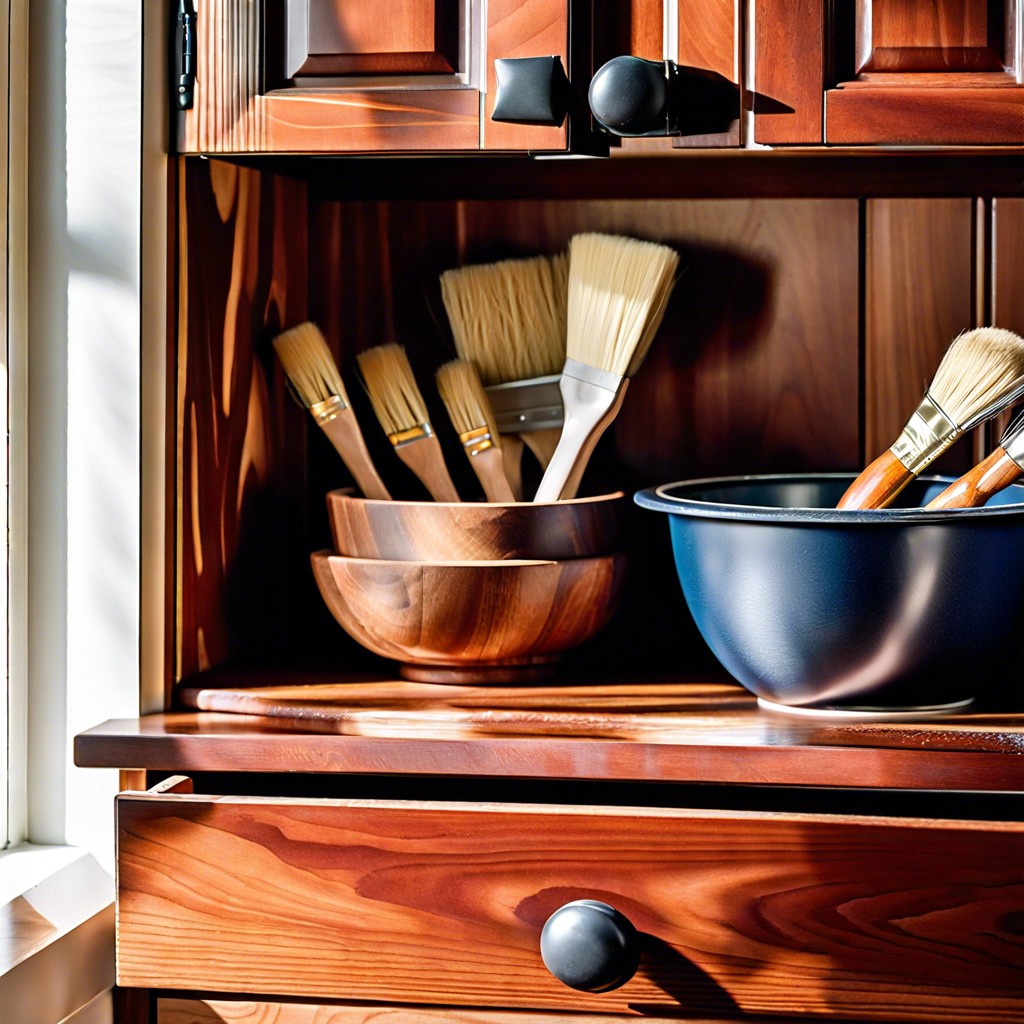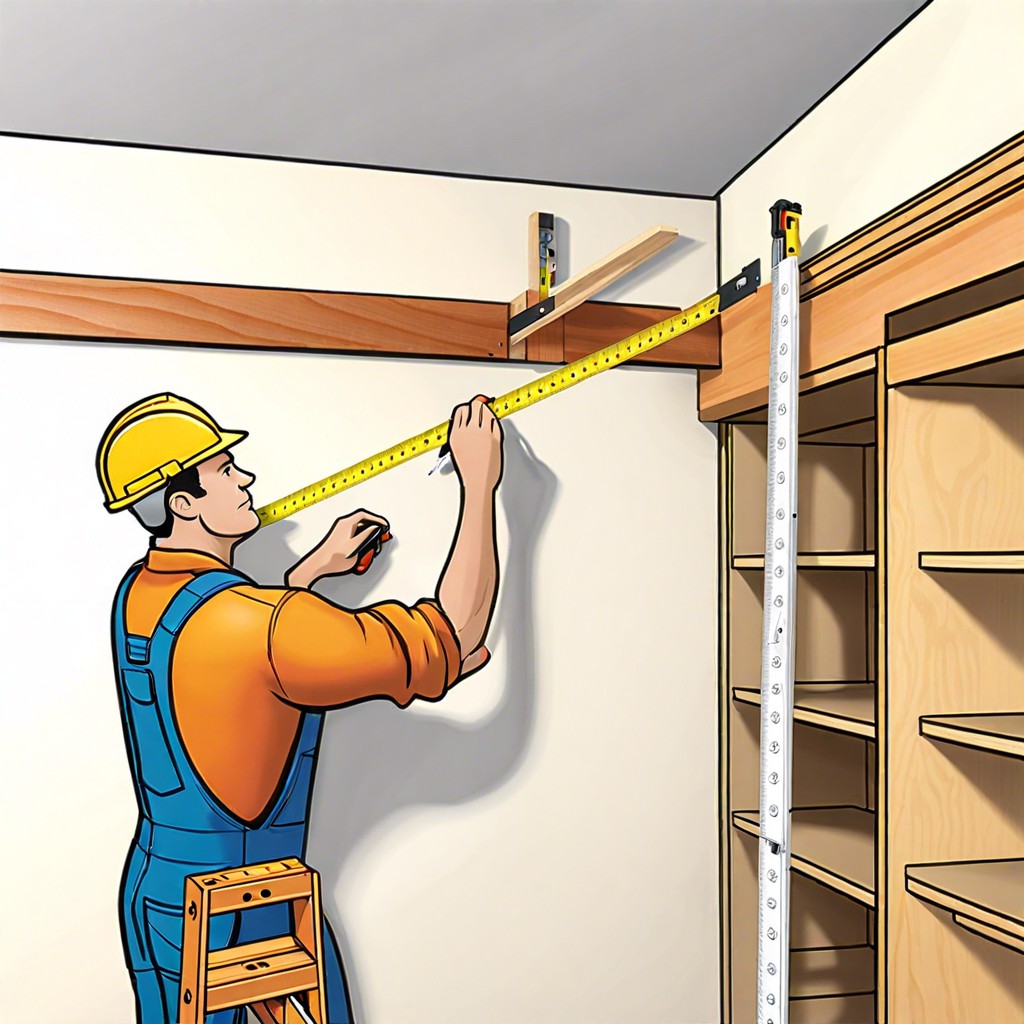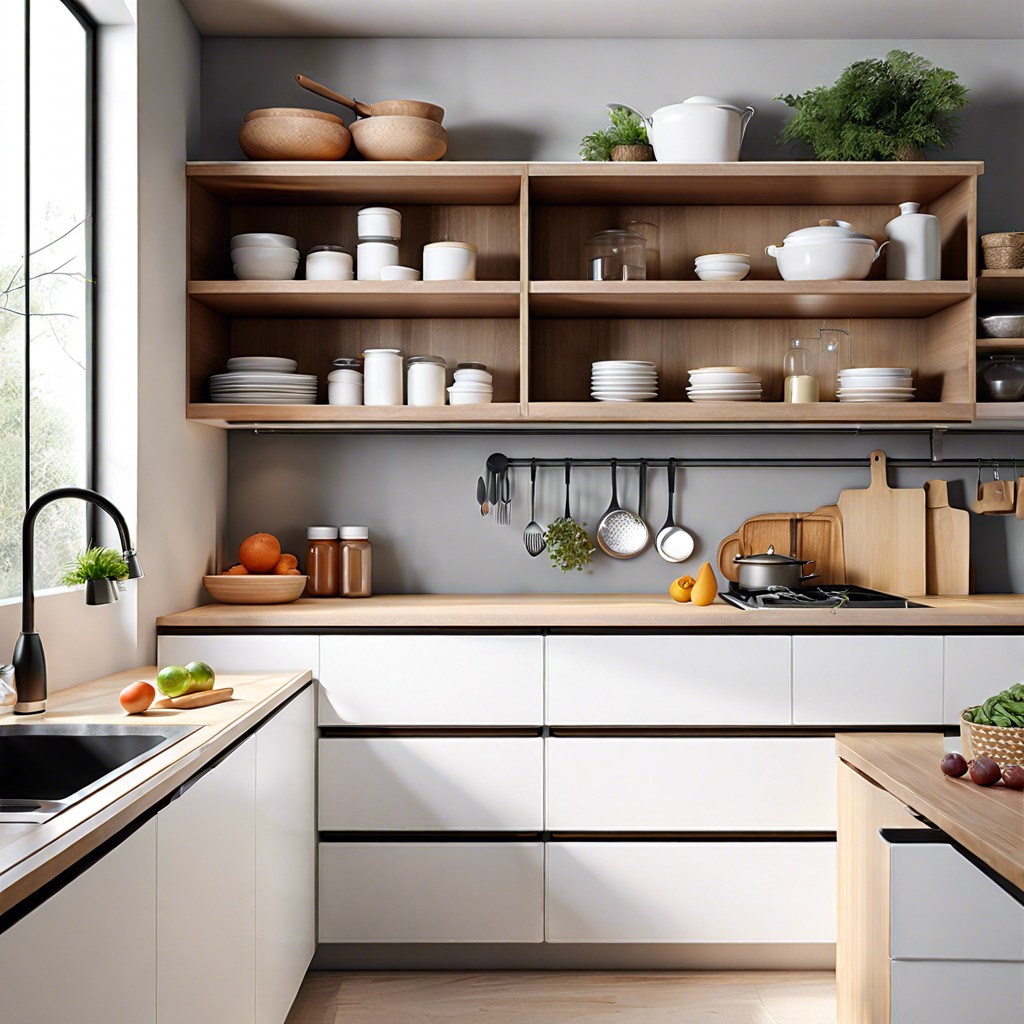Last updated on
Selecting the perfect glass thickness for cabinet doors can transform your space, because it plays a critical role in durability, aesthetic appeal, and functionality.
These are my unique design concepts made using design tools. I hope you find them inspiring!
Embarking on a quest to craft unique glass cabinet doors? Dive right into a world of innovation as this article opens the doors (pun intended!) to explore an array of fresh, unique perspectives on glass thickness for cabinet doors. Sure, there are numerous ideas found online. For those tried and true methods, relevant resources will be provided at the end of the article. However, prepare to be dazzled with our curated list of distinctive ideas and inspiring angles, conceived to breathe new life into your cabinet doors and help you truly make a statement in your home decor. Dare to stand out with glass designs made to impress – let’s begin the journey.
What's Inside
Impact of Glass Thickness On Overall Cabinet Design
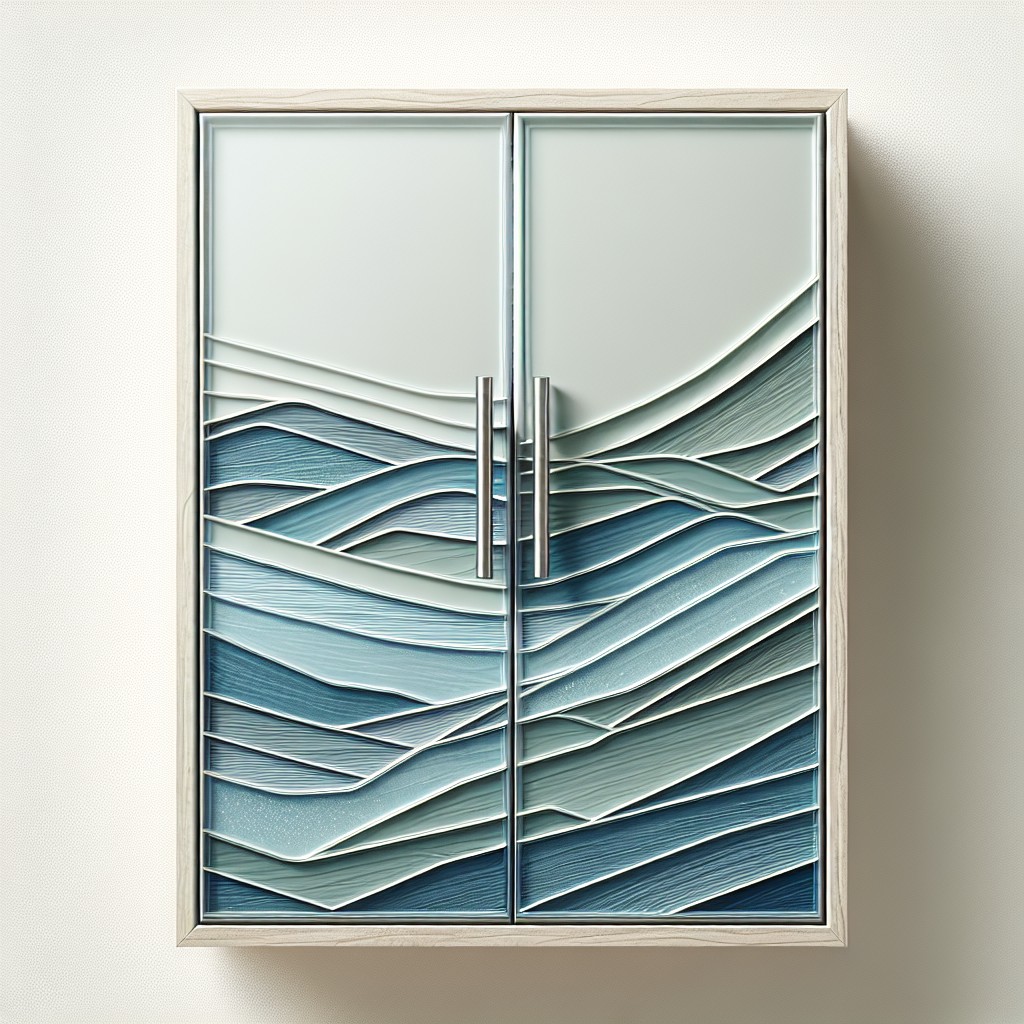
Choosing the correct glass thickness can actually make a significant difference to the overall design aesthetics of your cabinet. The standard thickness for glass used in cabinet doors usually ranges from 1/8 inch to 3/8 inch, but it’s not uncommon to find higher thicknesses for a more substantial and sturdy feel. When you opt for thicker glass, it tends to add an impression of luxury and weight to the design. It works splendidly for a more traditional or vintage style where solidity is a key design factor.
Meanwhile, thinner glass lends itself well to a sleek, modern, or minimalist design. Its barely-there quality lets the inner contents shine through and can create an interesting visual when lit properly. It’s also ideal for cabinets with intricate framework that you don’t want overshadowed by the glass.
Consider also the weight and balance. Thicker glass is heftier – ensure your cabinetry can support it. Play with the light reflection and refraction as well. Thicker glass distorts and refracts light differently compared to a thinner pane, ultimately affecting the mood and ambiance of the space.
Remember, it’s all about coordinating the thickness with the desired style, functionality and practicality of your cabinets.
Experimenting With Multi-Pane Glass Cabinet Doors

When it comes to multidimensional appeal, multi-pane glass cabinet doors truly shine. Their design consists of several small glass sections, framed by the door material, offering an interesting aesthetic. These doors not only add visual interest but also have practical aspects:
1. Light Dispersal: Multi-pane glass allows light to scatter, brightening up the cabinets and making their contents subtly visible, ideal for showcasing your decorative china.
2. Customization: You can mix and match different types of glass in one door, providing unique design opportunities. Consider frosted with clear glass panels or colored with transparent ones.
3. Strength: Contrary to what one might assume, having multiple small panes can result in a more robust door. Damage to one pane is less likely to compromise the entire door.
4. Flexibility: They can adapt to several styles, from country to contemporary, fitting seamlessly into your particular design philosophy.
5. Replacement: If a pane gets damaged, it’s simpler (and often cheaper) to replace a single pane than an entire glass door.
Do keep in mind that multi-pane doors require a bit more effort in cleaning due to the additional grooves and edges. Also, the more complex design could slightly elevate your budget. Thus, entering this glass infinity requires a balance between aesthetics and practicality.
Using Etched Glass in Cabinet Doors
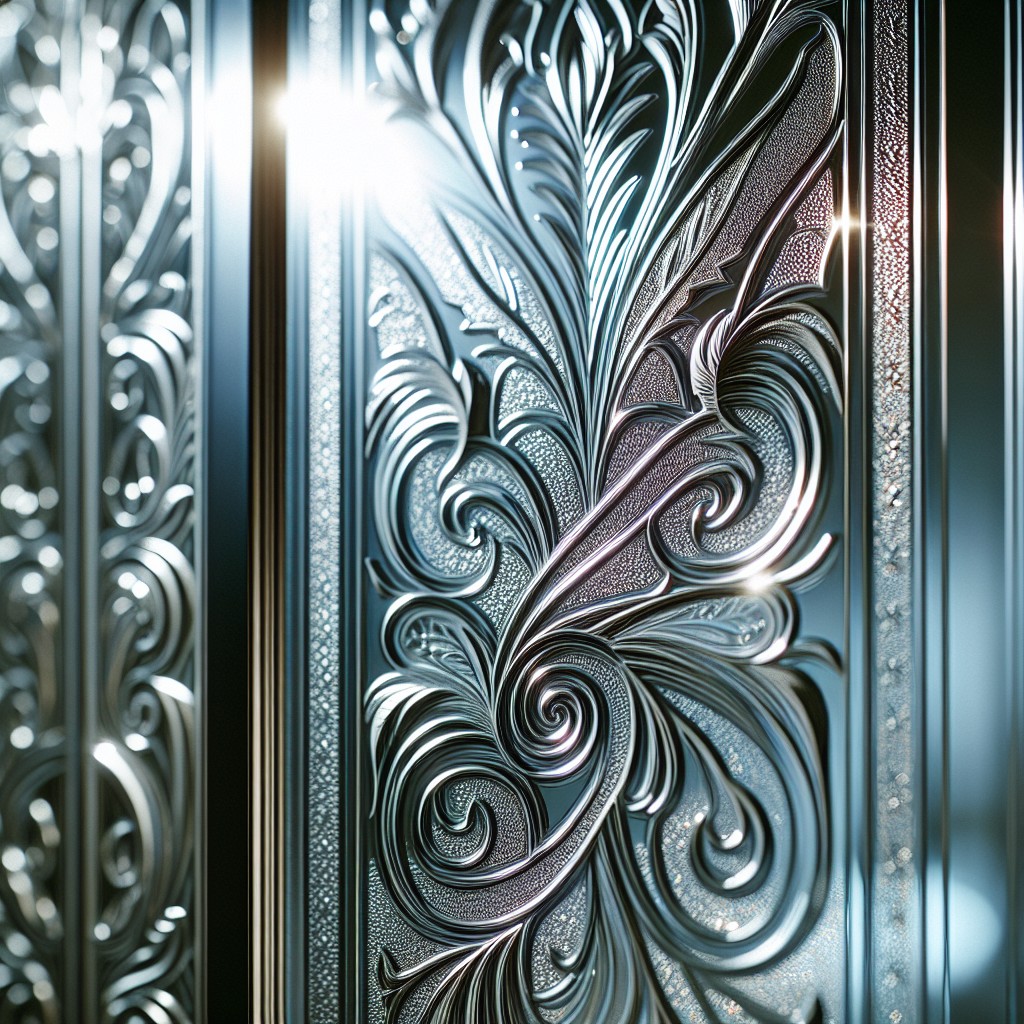
Etched glass creates an aesthetic appeal to your cabinet doors. It adds texture and pattern while being able to maintain privacy due to its semi-opaque nature. The technique involves removing glass surface layers to design intricate patterns ranging from geometric designs to floral motifs; possibilities are boundless accommodating any décor.
Etched glass offers an added advantage of being a practical stain-resister. Unlike normal glass doors, etched ones camouflage smudges and fingerprints which can be an advantage in high-use areas like the kitchen or bathroom. On the flip side, care and cleaning of this glass type can be a slight bit more demanding due to the grooves and dips in the surface.
To incorporate etched glass in your cabinet doors, approach professionals who can cater to your desired outline and accommodate your specific design needs. Remember, with custom etching, you can transform simple storage pieces into conversations starters. Making small or large patterns reflect personal aesthetic is one of the joys of choosing etched glass. For those wanting less maintenance, you can opt for etched patterns only on the edges of the cabinet doors, balancing both practicality and style.
Stained Glass Inclusion for Cabinet Doors
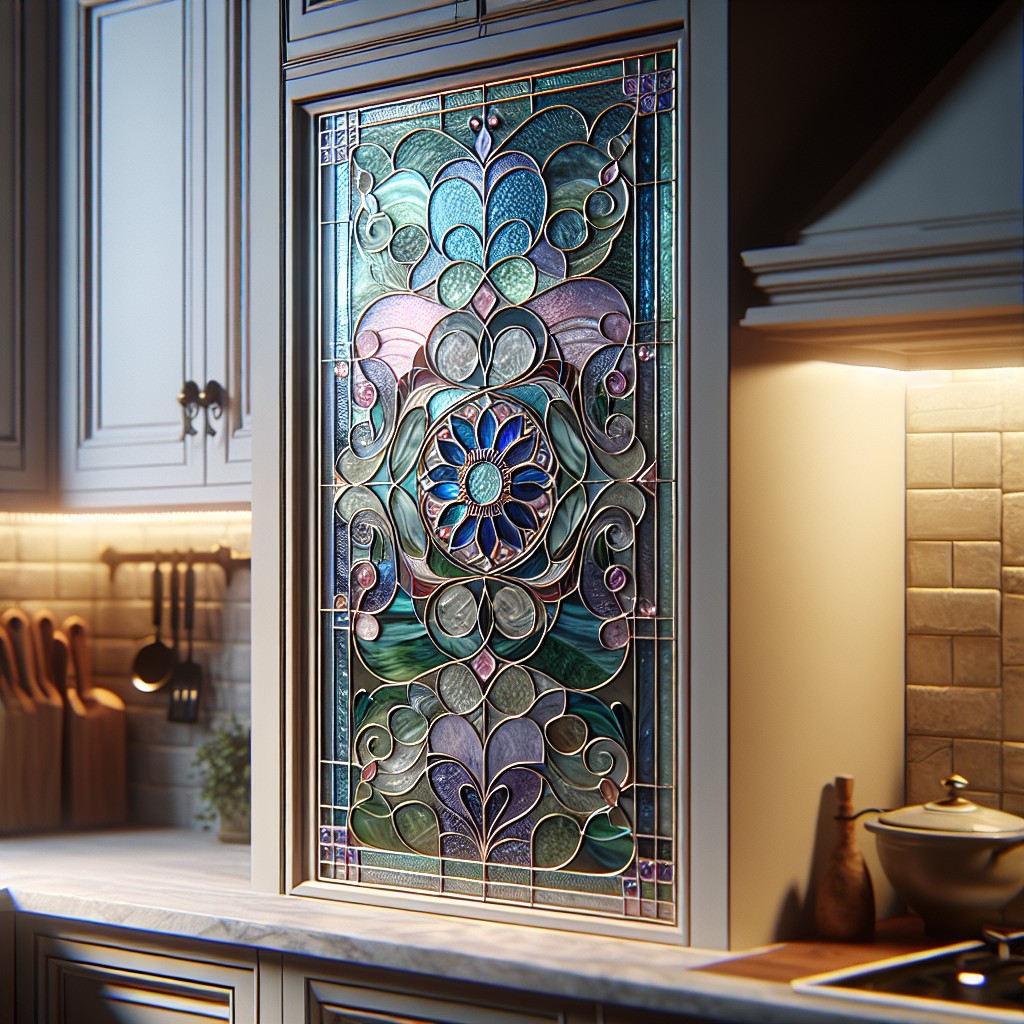
Stained glass offers an elevating touch that allows homeowners to bring artistic novelties to their cabinets. The play of colors that glint through the glass can add a sophisticated allure to the kitchen or bathroom. They offer a fantastic route for personal expression while upholding privacy.
When opting for stained glass, consider the design meticulously. Simple, abstract patterns can be a good fit for modern style, while gothic or floral motifs can echo well with traditional decor. The color scheme should be decided to blend or accentuate the overall room decor.
Stained glass cabinet doors require careful handling and routine dusting to retain their charm. Utilize a microfiber cloth that won’t scratch the surface. Specialist stained glass cleaning solutions are available which can keep the intricate designs sparkling.
Remember, stained glass might not be suitable for homes with small children. Safety should be your priority as these glass types can shatter with significant impact. Always consider the balance between aesthetics, practicality, and safety when employing stained glass in cabinet doors.
Safety Measures With Glass Cabinet Doors
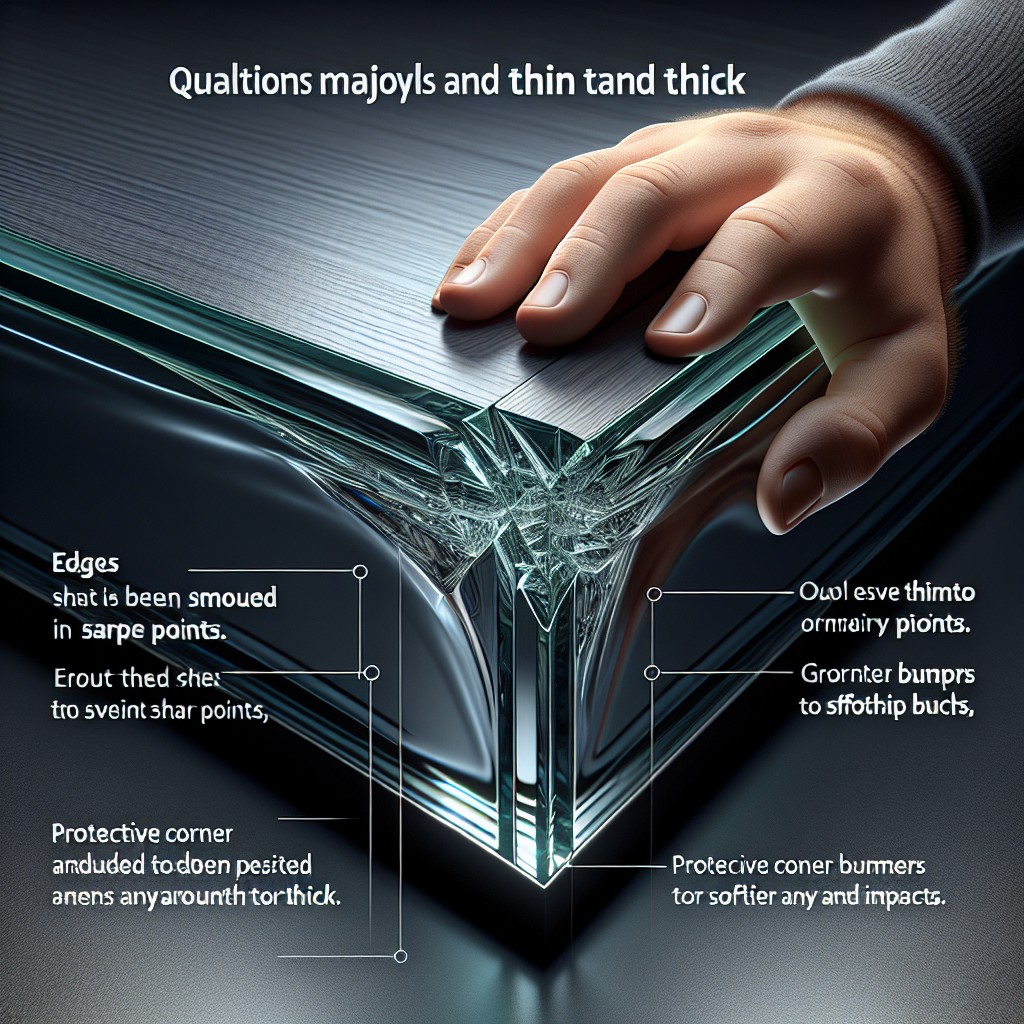
Ensuring the safety of your glass cabinet doors is paramount, particularly in households with kids or pets. Firstly, opt for tempered glass when selecting the material, as it’s not only more robust but also shatters into tiny, less harmful particles, reducing risk of injury.
You should also consider soft close hinges, which will prevent doors from slamming shut and potentially shattering the glass. Edges and corners, especially, should always be rounded off or installed with bumpers to mitigate possible accidents.
Lastly, to maintain their longevity, cleaning should be done using soft, non-abrasive materials and solutions specified safe for glass to avoid scratches and other damage.
Using Tinted Glass for Privacy in Cabinet Doors
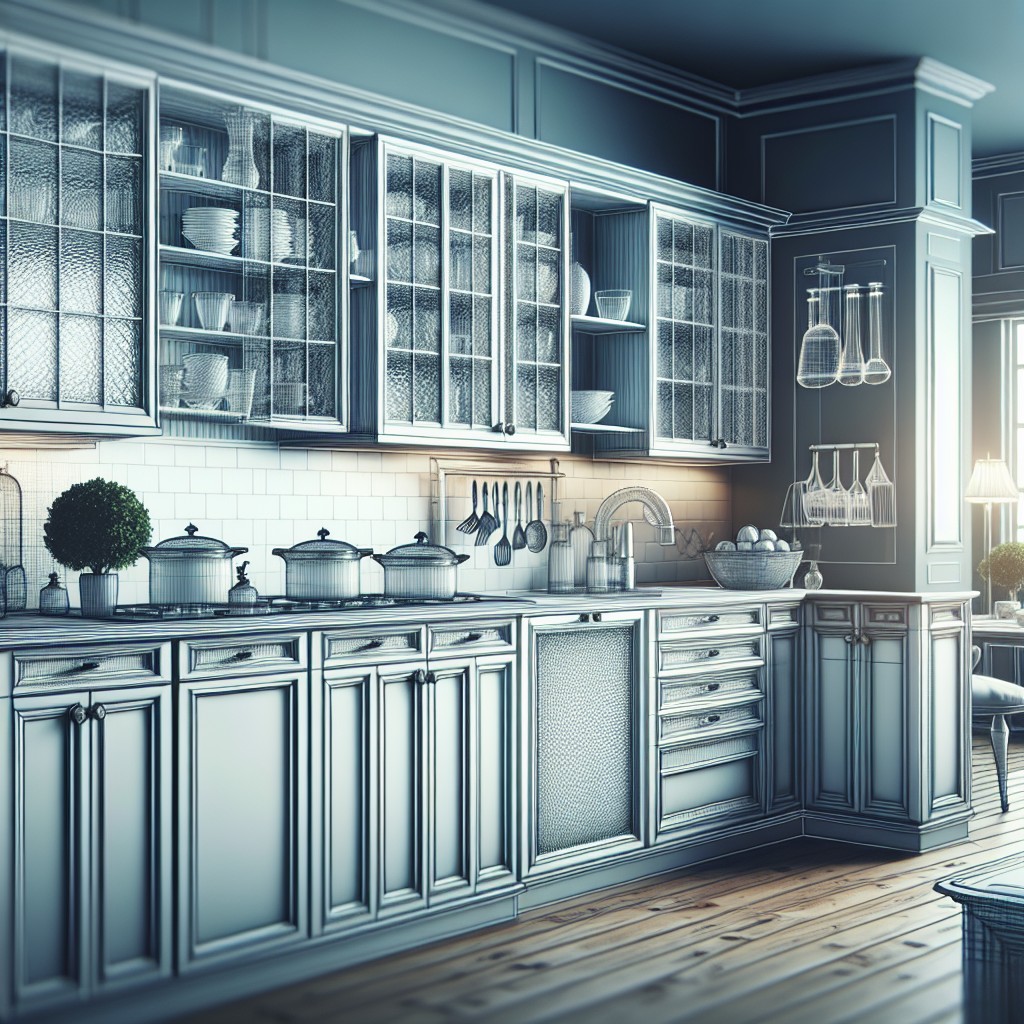
Tinted glass maintains the sleek aesthetics of glass cabinetry while subtly veiling the contents inside. This privacy-centered design is ideal for those who prefer keeping their items discreet or for cabinets containing more cluttered or mismatched objects.
Deeper tints offer more obscurity while muted tones permit a softer glow, allowing a peek inside without fully exposing the contents inside.
One of the advantages of using tinted glass is its wide spectrum of available shades – from smoky greys to amber tones and beyond, you can choose a hue that best complements your existing decor.
Additionally, tinted glass also provides a reduction of glare from internal lighting, providing a comfortable view of the cabinet interior without harsh reflections.
Installing tinted glass is largely similar to clear counterparts, but it’s critical to carefully select the right intensity of tint to balance privacy and visibility.
Lighter tints work well for larger spaces that can handle a bit of exposure, while darker tints are best for smaller areas intended to downplay the items inside.
Durability Comparison: Thick Vs Thin Glass Cabinet
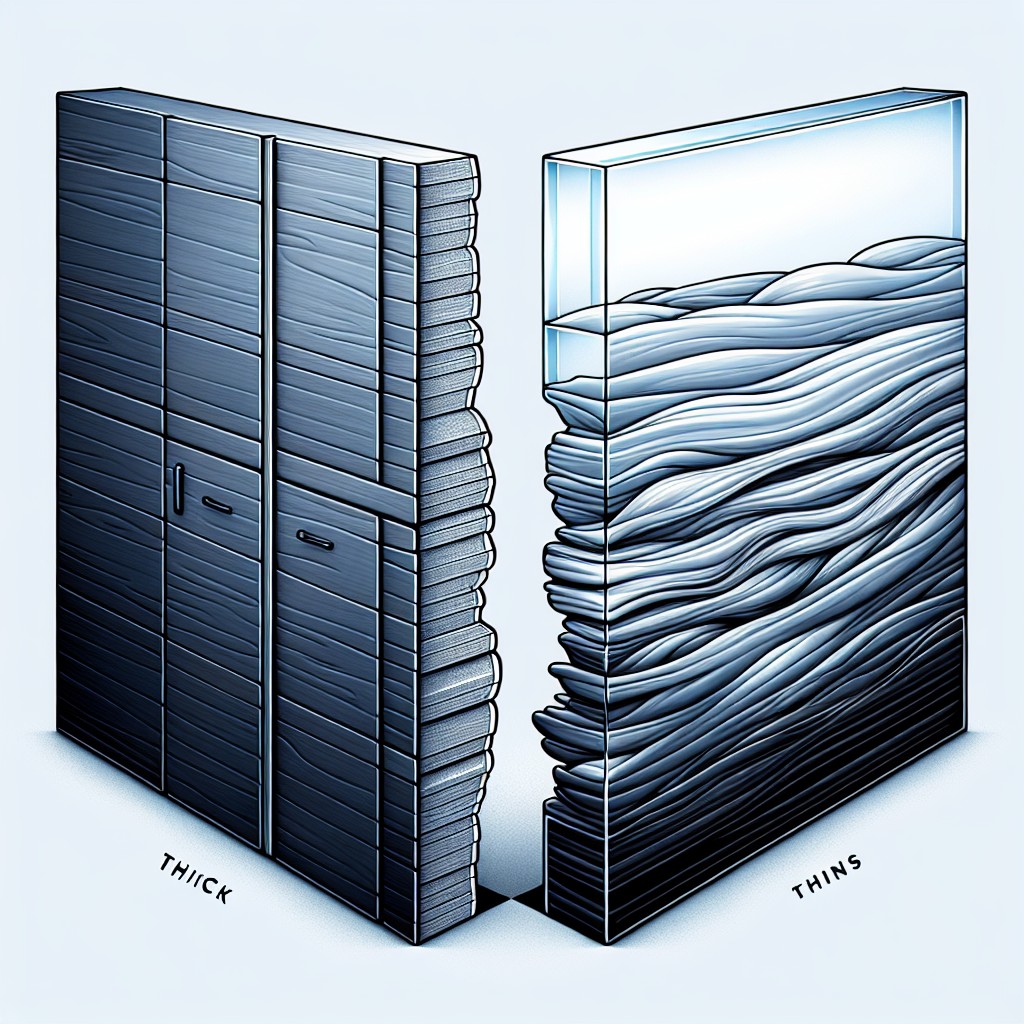
For long-lasting cabinet doors, especially in high-traffic areas, it’s better to use thicker glass. Generally, the resilience of glass grows with its thickness. Thicker glass, something above 5/16-inch, tends to hold up better under frequent use, resisting breakage and damage. Plus, if you worry about your children or pets running into the doors accidentally, thicker glass might be the picker-upper for you.
However, it’s important to remember that it will add significant weight to the cabinet doors. You’ll have to install a robust cabinet foundation and sturdy hinges to support the weight. Furthermore, thicker glass is more expensive compared to thin glass, which might be a deciding factor depending on your budget.
On the contrary, thinner glass, while not matching the durability of thicker variants, can still offer a clean, sleek look to your cabinets at less price and weight. Plus, modern methods in glassmaking have improved the strength of thin glass too, making it reasonably resistant to accidental bumps and knocks. Just remember, with thinner glass, you have to be a bit more careful with stronger impacts.
In a nutshell, when deciding between thick and thin glass, consider the usage and location of your cabinets while thinking about how much weight and cost you’re willing to accommodate.
Pros and Cons of Emerald Glass for Cabinet Doors
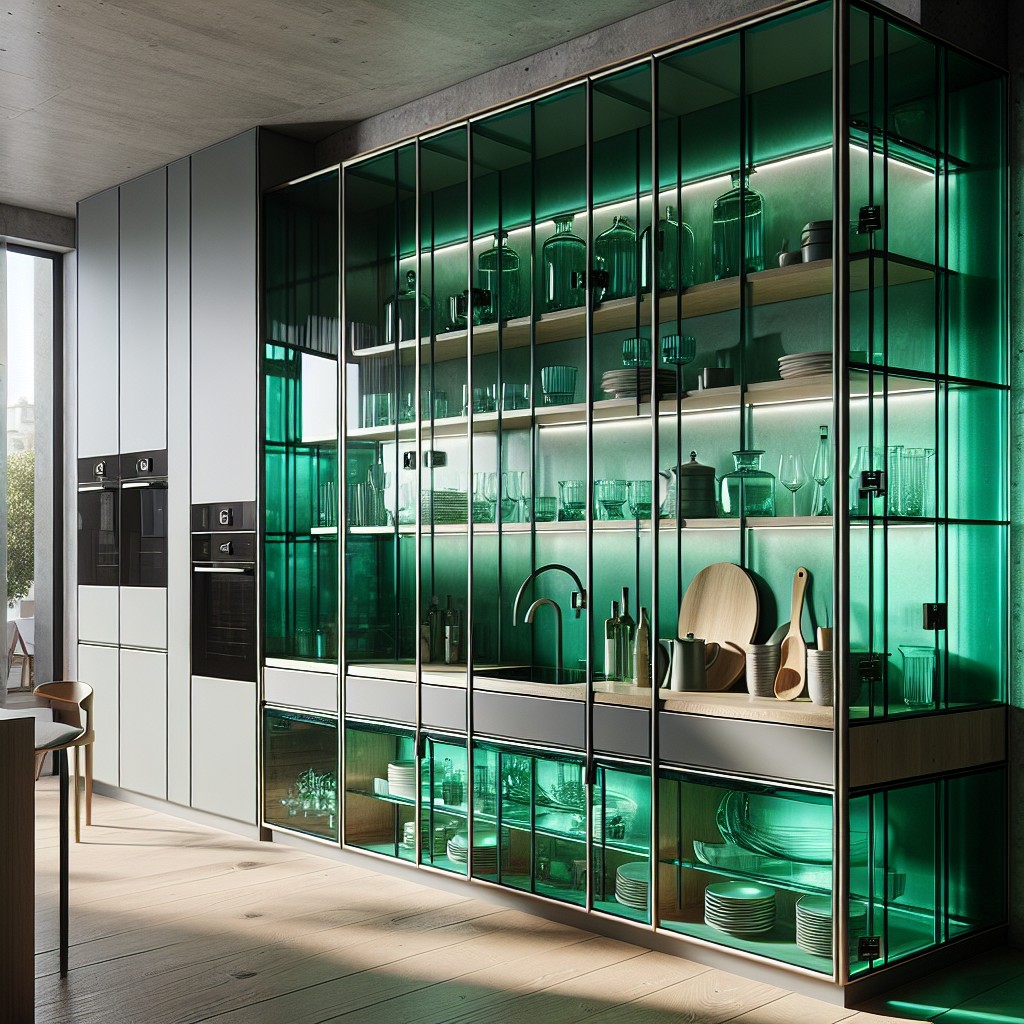
Emerald glass can instantly glam up any cabinet, adding an interesting pop of color. Its unique green tone can provide an eye-catching finish to your cabinets, good for kitchens wishing to add a certain charm.
Luxurious in its appeal, it works great in high-end, modern kitchens complimenting metallic finishes like brass or gold.
However, a drawback of using emerald glass is its cost. Typically, it’s more expensive than regular glass due to its color and the process to create it. It’s also bold, which may not blend well with all interiors. So, careful consideration of the overall design is necessary.
Lastly, with its dense color, the visibility of items inside may be reduced, which can be a negative if you were hoping to use the glass to showcase your dishware.
In conclusion, while emerald glass can certainly add a dose of personality to your kitchen, costs and the fact that it may not match every interior need to be taken into consideration.
The Appeal of Bubble Glass Cabinet Doors
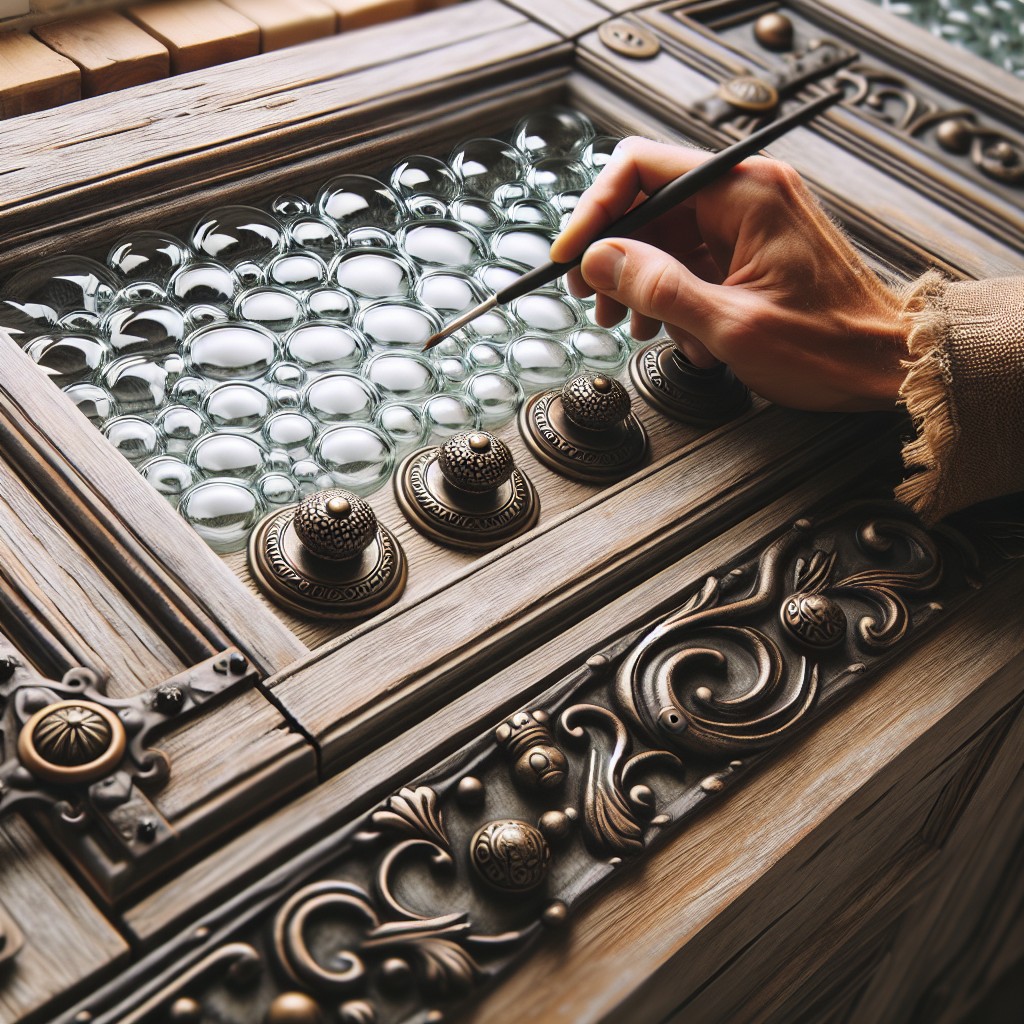
Bubble glass is an effortlessly charming variety which gives a vintage flair to your cabinets. Renowned for its unique surface dotted with slight, controlled imperfections referred to as ‘bubbles’, it effortlessly creates a soft, diffused light effect. While offering an appealing visual interest, it also allows for a certain degree of privacy for the contents of your cabinet.
By pairing it with a range of wood tones and finishes, bubble glass can successfully fit into both traditional and contemporary kitchen themes. In the modern setting, coupling this glass style with industrial metal cabinets results in an exciting blend of old-time charm and contemporary sleekness.
To ensure longevity and resist wear-and-tear, opt for a thickness minimum of 1/8 inch. Remember, your glass should be durable but also feasible to replace should an accident occur. Always consult a professional when cutting or handling glass to avoid any mishaps.
Adapting to different lighting conditions, bubble glass offers an enchanting glow when backlit which can effortlessly uplift your cabinet’s aesthetic appeal. It is not only vogue but functional, providing a stylish yet subtle coverage for your cabinet interiors.
Required Equipment for Customizing Glass Thickness
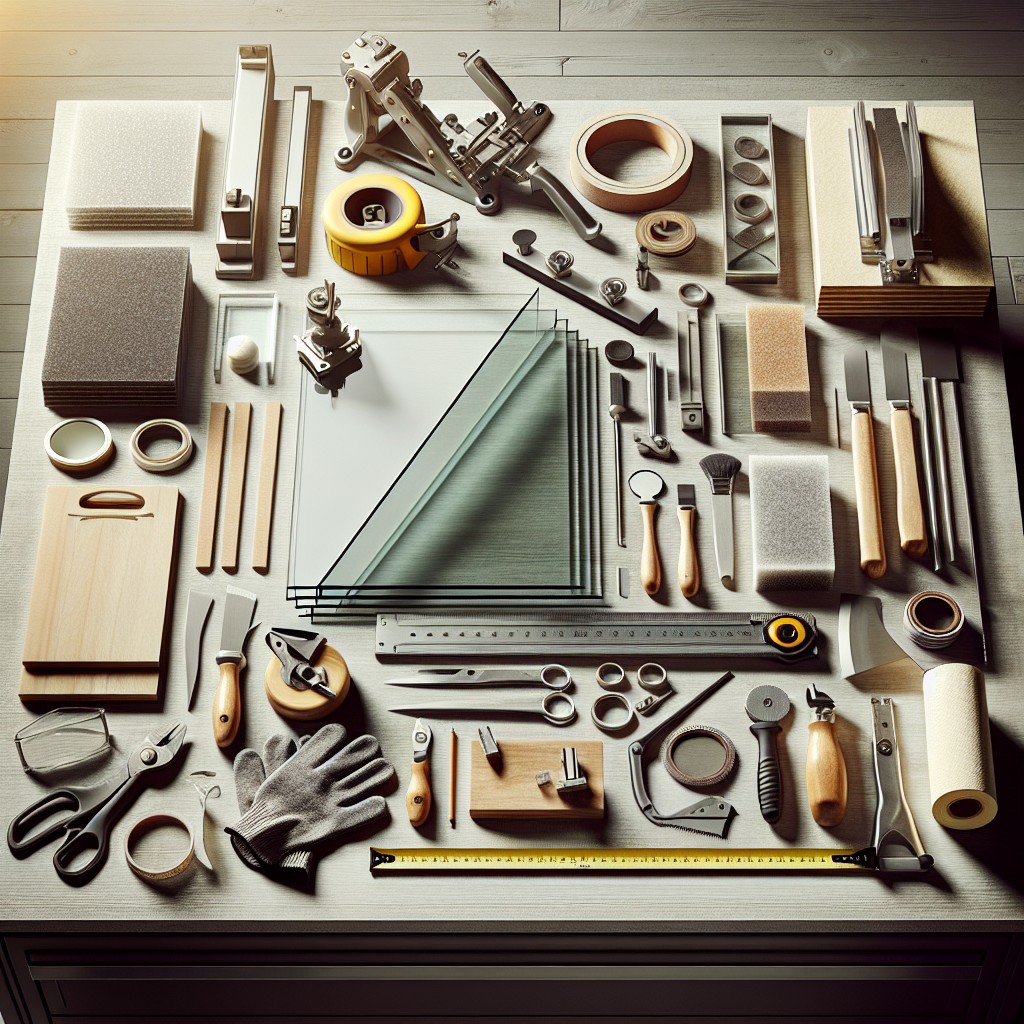
Gear up with the right tools to improve your cabinet glass customization experience. Begin with a quality glass cutter, mandatory for precise cuts. Then, a straight edge or square is essential for flawless straight lines. Also, incorporate a strong pair of running pliers – they help break the glass along your cut lines without any unwanted damages.
To control glass thickness, a standard wet saw is crucial. It allows an adjustable blade height, providing an effortless way to modify the thickness of the glass. But remember, you’ll need a diamond blade due to the glass’s abrasive nature.
Safety cannot be compromised while handling glass. Thick, durable gloves, safety glasses, and a working apron are a must to protect against possible injuries. Lastly, don’t forget a high-quality mastic adhesive for securing your customized glass to the cabinet door frame. Make a note that the adhesive should be strong enough to hold the weight of the glass, especially if it’s on the thicker side.
Master the basics of handling these tools before proceeding. They not only ensure precision and quality in your project but also promote a safe working environment. This way, customizing your cabinet glass won’t be intimidating anymore.
Price Analysis: Glass Thickness and Its Effect On Cost
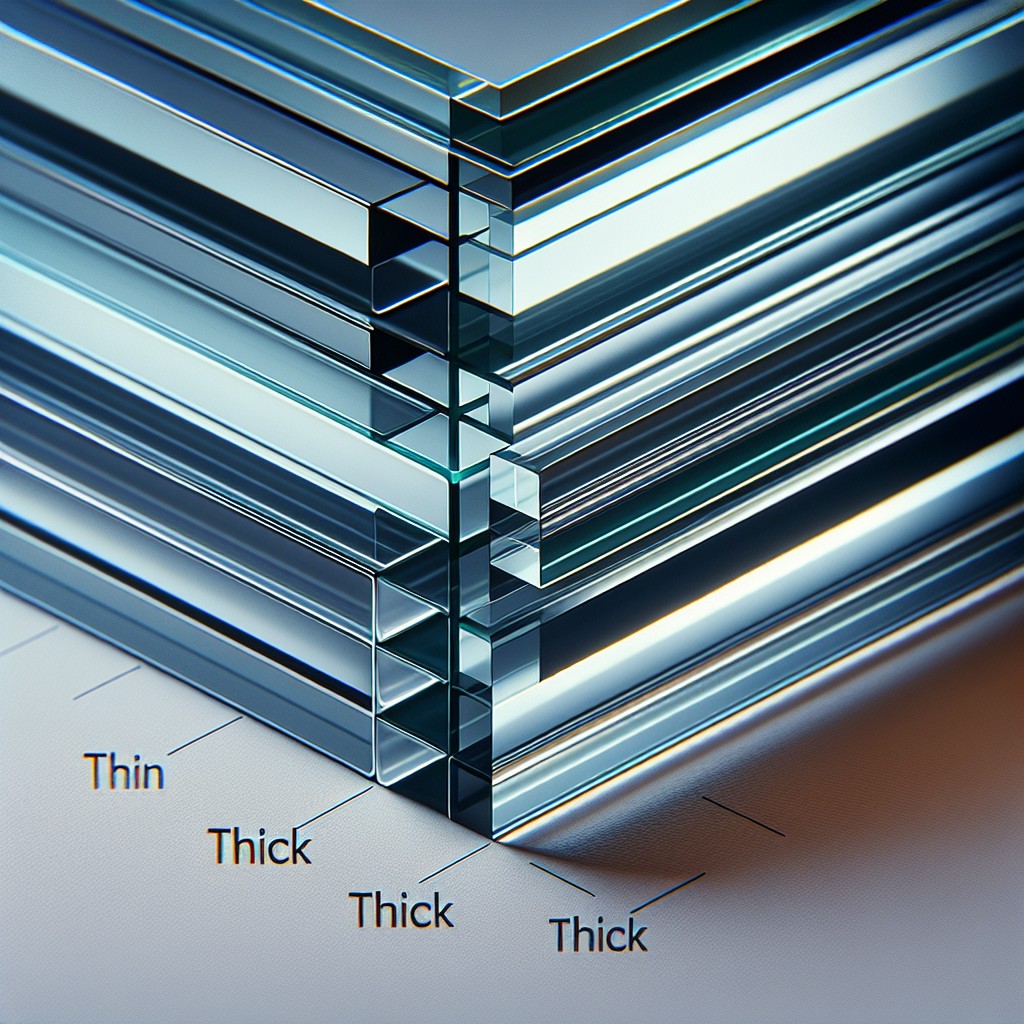
Typically, thicker glass comes at a heftier price due to the amount of material and effort required in its production. The cost per square foot can go up due to its increased durability and resistance to breakage. That being said, don’t dismiss thicker glass as an unnecessary expense.
Consider it as an investment towards longevity of your cabinet doors and, thus, an opportunity to save on potential repair or replacement costs in the future. The premium quality and aesthetics it brings to your space may make the extra spend worth every penny. Also, thicker glass tends to soundproof better which might be of value in certain environments.
On the other hand, if you’re on a tight budget or dealing with less frequently used cabinets, opting for a thinner glass can cut costs without sacrificing style. It’s lighter, easier to handle, and for light-duty applications, can be more than adequate.
Remember, always weigh your options before buying. Measure your need for durability and aesthetics against your budget and choose wisely. After all, both thick and thin glass doors can add charm to your cabinetry, it’s all about finding the balance.
Maintenance Tips for Thicker Glass Cabinet Doors
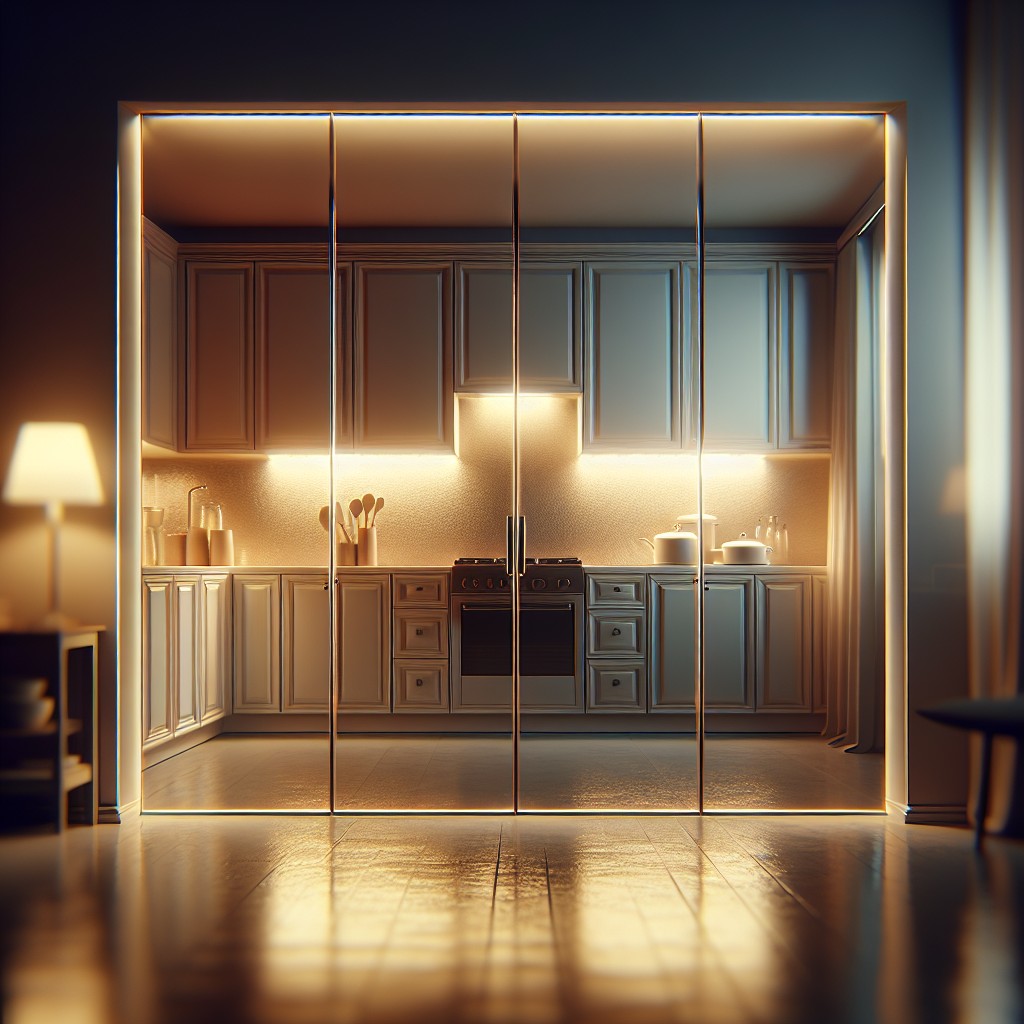
Take note of the following tips to keep your thicker glass cabinet doors in top condition:
1. Regular Cleaning: Use a microfiber cloth and cleaning solution specially made for glass. Avoid strong chemicals that can etch or discolor the surface over time.
2. Scratch and Dent Maintenance: Prevention is key here. Be mindful when opening and closing the doors and avoid bumping or scraping with hard objects.
3. Frame Care: If your glass is framed, remember to clean and maintain the frame too. Moisture trapped between the glass and frame can lead to unsightly stains or rust in metal frames.
4. Inspection: Every so often, do a thorough check. Signs of hairline cracks or chips at the edges can be addressed immediately, preventing them from becoming major issues.
5. Decals and Stickers: Be careful with these decorations as removing them can risk scratching or leaving tough residue. Use a gentle glass-safe adhesive remover if needed.
By following these tips, your thicker glass cabinet doors will retain their shine and durability for years to come.
The Ins and Outs of Installing Ribbed Glass to Cabinets
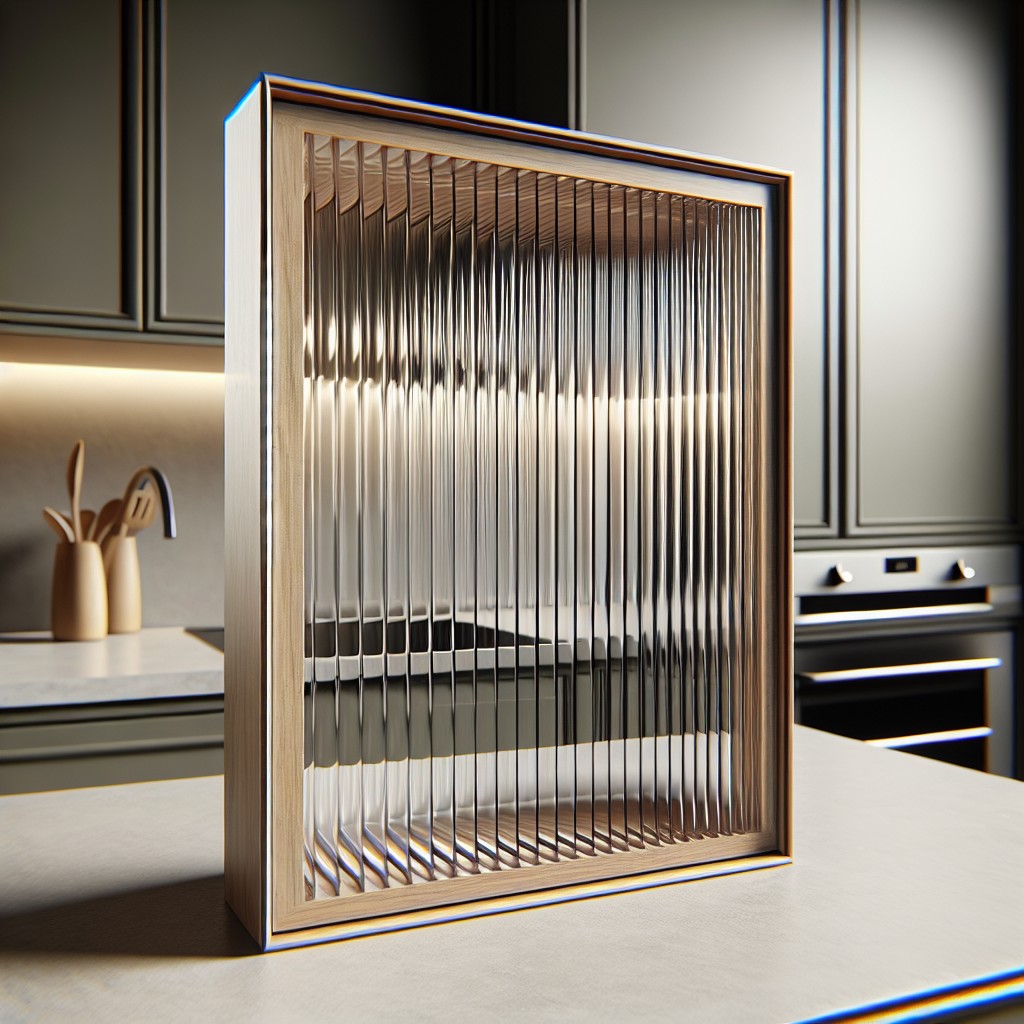
The installation process of ribbed glass bears certain nuances. For an easy start, ensure to take precise measurements of your cabinet door which will guarantee a perfect fit for the glass. Knowing your specifics can ease the ordering process, given the fact that most ribbed glass will have to be custom cut.
Preparing the cabinet door’s framework is essential. Begin by removing any existing glass and cleaning the frame thoroughly. If fresh paint is required, apply it before the arrival of the new glass.
Once the ribbed glass arrives, install it using silicone adhesive. Apply it sparingly at first, adjusting as necessary for firmness. Avoid overuse as it can lead to unwanted smudging. Next, install retainer clips, which should be spaced evenly around the frame, to securely hold the glass.
Always keep in mind that precautions must be taken when working with glass. Utilize safety gloves to mitigate the risk of cuts or bruises. Also, your cabinet door should be open during the installation process to avoid any pressure that could lead to cracking.
Turn to a professional if you feel uncomfortable doing the task yourself. Some may offer installation as part of your order, or even give you a discount if you choose to bundle services. Properly installed ribbed glass can not only enhance the aesthetic appeal of your cabinets but also increase their durability.
Going Green: Recycled Glass for Cabinet Doors
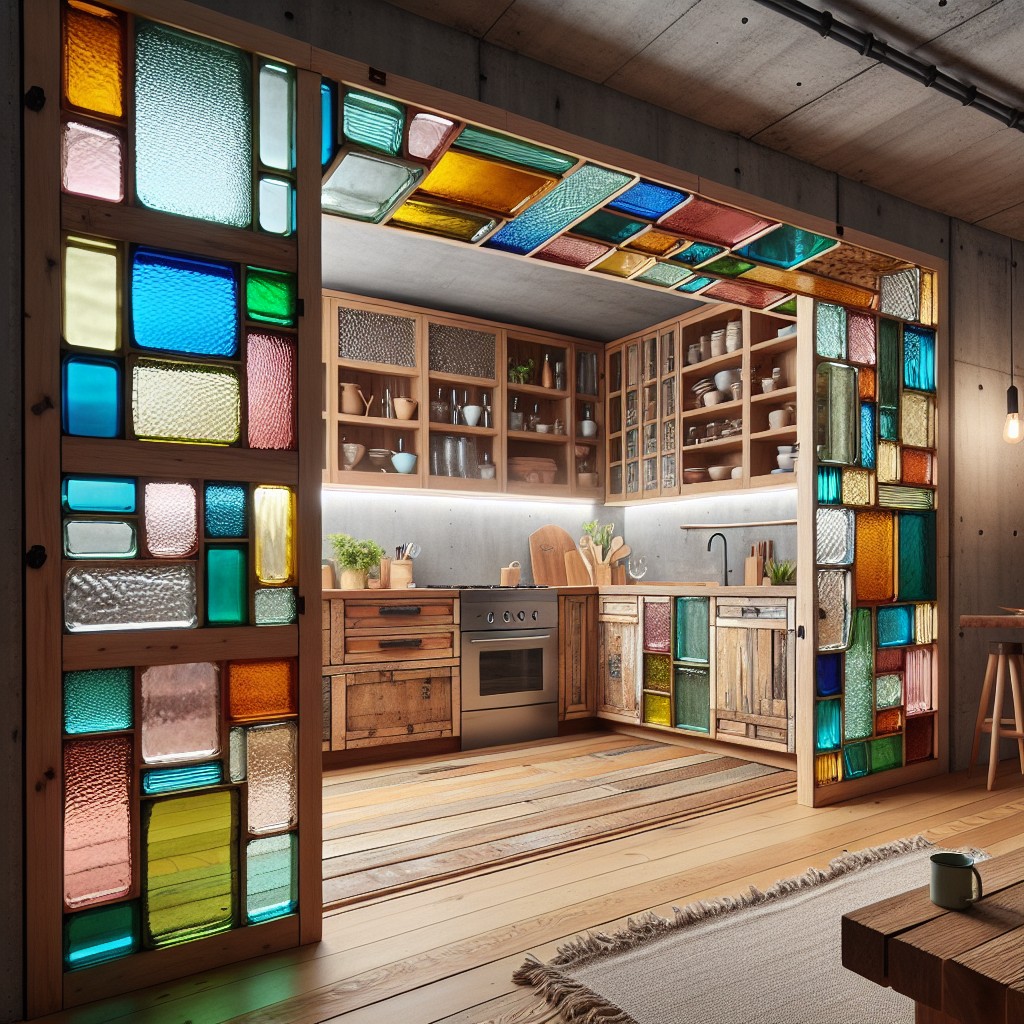
As an eco-conscious home decorator, sourcing materials that minimize environmental impact without compromising on style can be a challenge. Thankfully, recycled glass dispels this notion, proving itself as both a sustainable and aesthetically pleasing choice for cabinet doors.
Firstly, it’s essential to note recycled glass’s versatility. Available in a wide array of tints, textures and finishes, this material can easily align with various home interiors – reinforcing its practicality.
Additionally, manufacturers often repurpose glass from a mix of sources, from old beverage bottles to discarded windows, thereby reducing landfill waste. Each piece has its unique blend of hues and patterns, delivering an original and bespoke look to your cabinet doors.
Be sure to assess the quality of recycled glass before purchasing. Some high-end offerings have a more refined finish with less visible imperfections. On the other hand, budget-friendly versions tend to exhibit more character, often with visible flecks or tiny bubbles present.
Finally, while recycled glass is generally robust, extra care should be taken when cleaning. Abrasive materials could scratch the surface; it’s advisable to use a damp cloth with a gentle cleaner to ensure its longevity.
Opting for Reeded Glass in Cabinet Doors
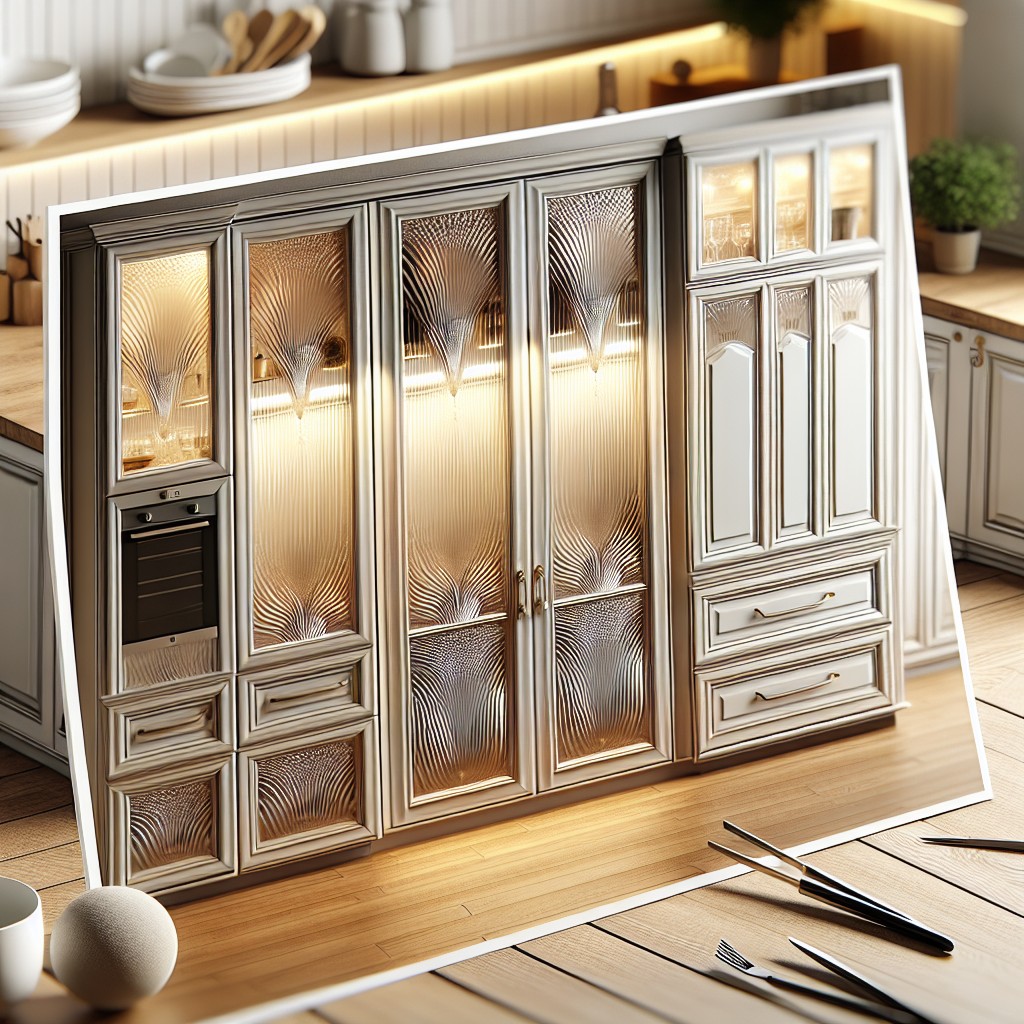
Reeded glass lends an interesting textural element to a kitchen that screams sophistication. This specialized material creates a series of vertical or horizontal ridges, creating a visual barrier while still allowing light to pass through. It’s an outstanding choice if you’re looking for moderate privacy without completely obscuring the cabinet’s interior.
Even though it is less common than its counterparts, leading edges in modern design incorporate it for small doses of delightful unpredictability. As an additional bonus, it adds an extra layer of sturdiness, making your cabinet doors more resilient.
Remember, selecting a high-quality reeded glass is key to achieving the right aesthetic appeal and ensuring durability. It’s recommended to consult with a professional to guarantee a perfect fit. Also, bear in mind that this glass type may need extra care during cleaning, due to its ridgy texture.
A Contemporary Look With Wire Glass Cabinets

Wire glass has been making a comeback recently, mainly in chic, urban environments for an edgy, contemporary appeal. This particular type of glass is often associated with industrial or commercial settings due to its embedded wire mesh, which adds a distinctive charm and character.
The embedded wire in the glass not only enhances aesthetic appeal but also increases safety. In the event of breakage, the wire mesh holds the shards together, reducing risk of injury.
Wire glass cabinets might pair well with modern stainless-steel appliances for a smooth, ultra-modern kitchen look. However, they can also juxtapose vintage or rustic decor, bringing an unexpected touch of modernity to traditional design.
Despite its robust look, wire glass is as malleable and versatile as other glass types. The thickness of wire glass generally varies from 1/4″ to 1/2″, which allows flexibility in design, whether it’s installed in a wall-to-wall cabinet or a standalone curio.
Reinforcing the maintenance aspect, its thick texture and pattern can help camouflage finger marks and dust, making it more user-friendly for everyday use.
Therefore, incorporating wire glass into cabinets brings about a unique blend of style, functionality, and safety all tied up in a sleek, contemporary package.
Choosing the Right Polished Edge for Thick Glass Doors
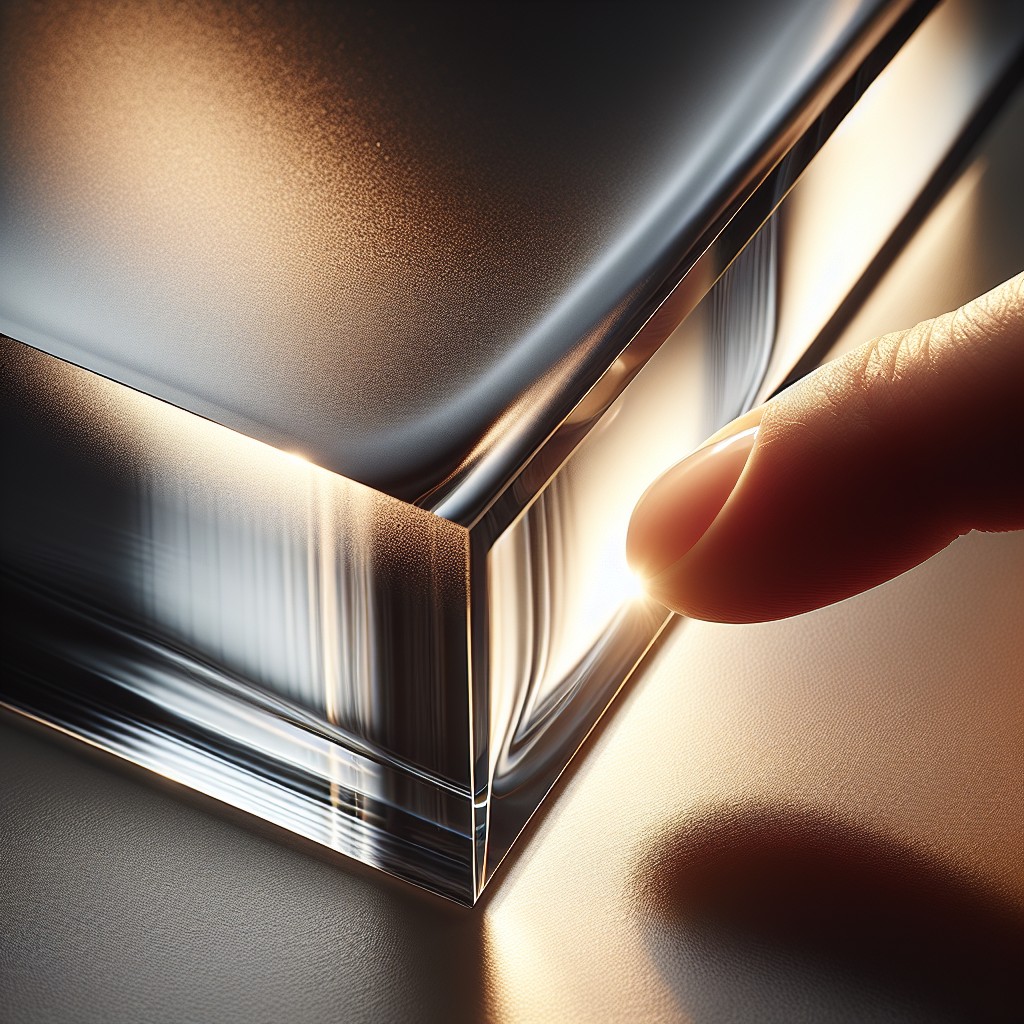
There are three main types of polished edges to consider. The first, a flat polish edge, gives your thick glass doors a minimalist look, with its sleek and smooth finish. This style is ideal when aiming for a modern, streamlined aesthetic in your cabinet design.
Alternatively, a pencil polish edge, rounded much like its namesake, provides an elegant, clean line that’s safe to touch. This design elevates the glass door’s overall appearance and works well with a classic or traditional decor style.
Lastly, the beveled polish edge, characterized by its angled cut, reflects light beautifully creating a visually appealing feature. This design style is perfect for those seeking a luxurious or high-end facade in their cabinet doors.
Remember, the choice of polished edge should not only satisfy your aesthetic preference but also complement the overall design theme of your space for maximum visual harmony.
Cabinet Door Trends: Merging Opaque and Transparent Glass
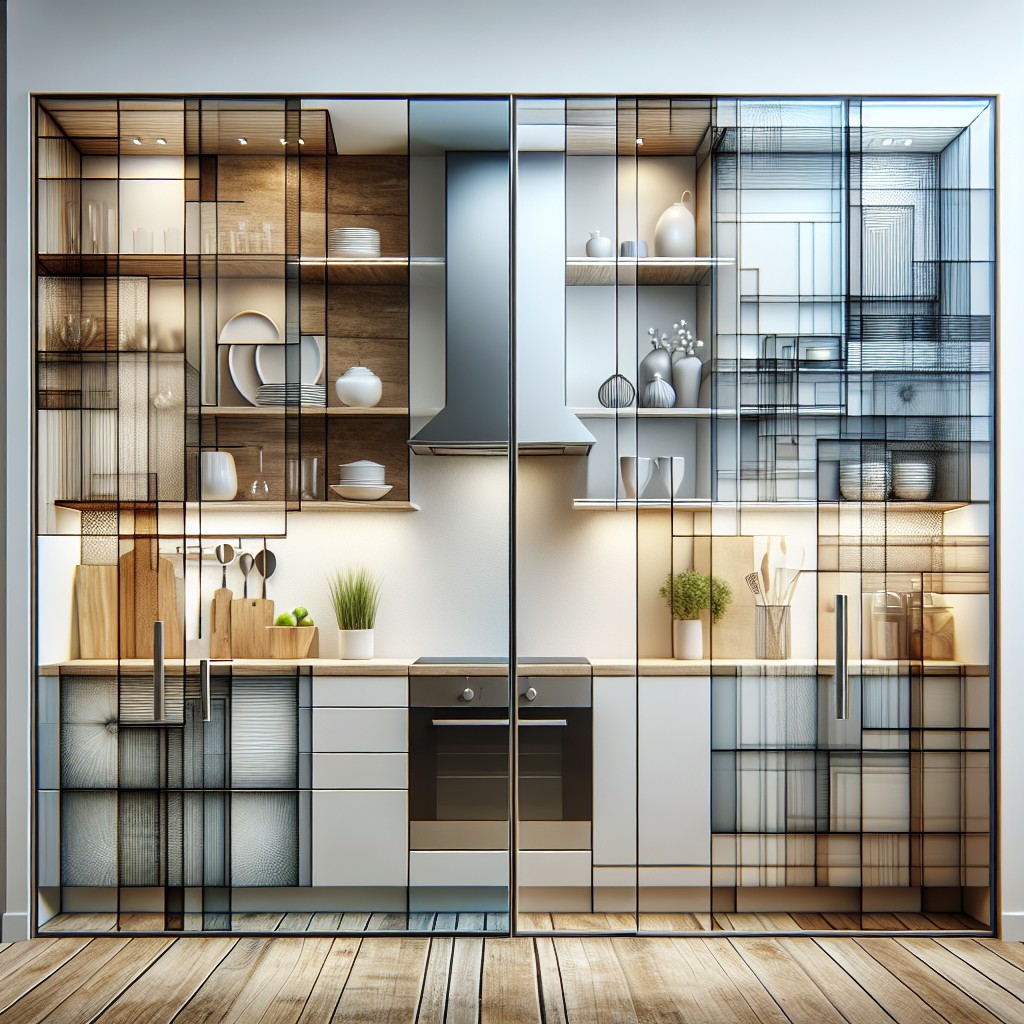
Crossover styles are gaining momentum in the cabinet world, particularly the fusion of opaque and transparent glass. This blend can enhance aesthetic appeal while tactically balancing the need for display and privacy. Here are some key considerations:
1. Creating Visual Interest: A cabinet door combining clear and frosted sections can add depth and visual interest to a kitchen or living room, attracting attention without being overwhelming.
2. Storage Versatility: Such a design allows you to keep some items in view while concealing others. This could be a lifesaver when you want your fine china on display but prefer to keep the less attractive pieces away from sight.
3. Light Control: Opaque sections can help in managing light penetration. This comes in handy if you have items that could be damaged by excessive light or just for an added layer of aesthetic control.
4. Personalization: This style offers high customization possibilities. You may have a gradient, alternating, or mix and match sections, depending on your preferences and needs.
5. Cleaning Convenience: Due to the presence of opaque sections, such doors tend to show less dirt or fingerprints, which makes them more maintenance-friendly.
Remember, whether you choose a checkerboard pattern, striped design, or a more randomized approach, this choice can breathe new life into your cabinets – making them functional and stylish.
Soundproofing Aspects of Thick Glass Cabinet Doors
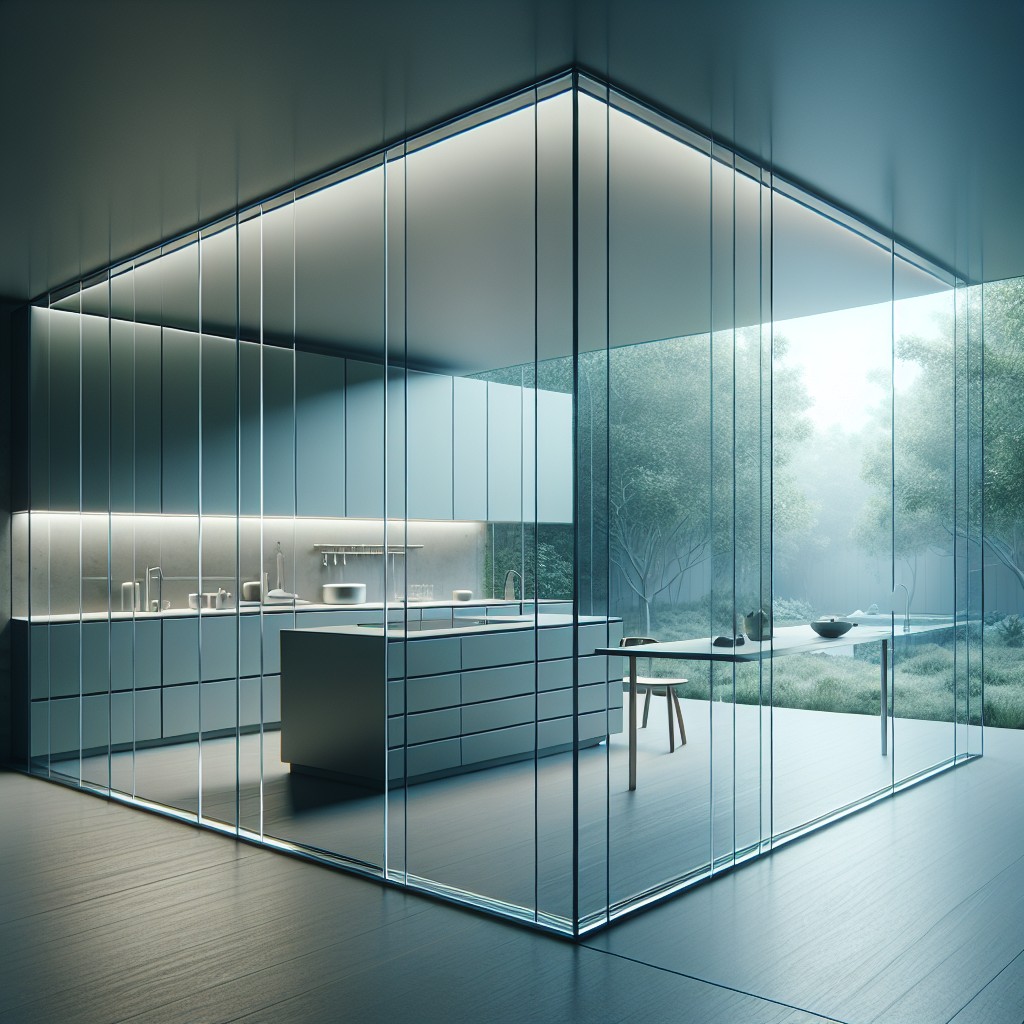
As you venture deeper into the realm of thicker glass, it’s essential to understand the added benefits. One significant advantage lies in its soundproofing capabilities.
Firstly, a thick glass door reduces noise transfer. This comes in handy if your cabinet houses noisy appliances, like a dishwasher or a fridge. Encasing them in a barrier of thick glass lessens the sound sneaking into your peaceful kitchen.
Secondly, the greater density of thicker glass provides better acoustic insulation. This can efficiently suppress the clinking noises as you shuffle through dinnerware stored in the cabinet.
Lastly, if your cabinets hold collectible glassware, thicker glass cabinet doors can absorb vibrations. It lowers the risk of your precious items clinking against one another.
Thus, the application of thicker glass in cabinet doors presents a subtle solution to maintaining a quieter and more serene kitchen environment.
Navigating Translucent Glass Options for Cabinets

Opting for translucent glass can prove an apt choice for those seeking both privacy and style. This variety of glass still allows the passage of light while obscuring the view. It’s perfect for storing visually unappealing necessities.
The general degrees of transparency can be varied based on personal preferences. Frosted and sandblasted glass are commendable options offering varying levels of translucency.
There’s also a myriad of designs available, e.g., etched or colored ones to align with your desired aesthetics. Don’t overlook the fact that the level of translucency might alter the color perception.
When selecting the hinge hardware, consider the door’s weight. The thickness of the glass influences the weight, potentially demanding hardware upgrades.
Remember, chiffon, linen or rain glass can add texture to the cabinet, raising the overall appeal. However, they may require more maintenance due to the intricate designs making cleaning a slightly bigger task.
It can be compelling to match your cabinet glass with other design elements in your space, such as windows or doors. But avoid making everything too matchy. Continuing the same visual theme is fine, but a little variety will maintain individuality and prevent your décor from looking too uniform.
Lastly, your preferred amount of translucency should also consider the illumination inside the cabinet. More diffused lights typically work best with translucent options. Don’t ignore the reflections and consider what is opposite your cabinets, whether it’s a wall color or an attractive backsplash.
Ideas Elsewhere
- https://www.madisonglass.net/glass-options-for-cabinets
- https://sawmillcreek.org/showthread.php
- https://ncwoodworker.net/forums/index.php
- https://cabinetdoorsnmore.com/blogs/news/upgrading-to-glass-mullion-cabinet-doors
- https://www.woodweb.com/knowledge_base/Dimensions_for_GlassPaneled_Cabinet_Doors.html
- https://thefrisky.com/type-and-thickness-of-cabinet-glass-doors-are-recommended/
- https://www.woodsmith.com/article/choosing-the-right-glass/
- https://pandakitchen.com/blogs/featured-articles/how-to-put-glass-in-cabinet-doors-professional-tips
